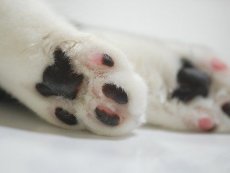New publications
Ten basic guidelines for caring for your cat's paws
Last reviewed: 04.07.2025

All iLive content is medically reviewed or fact checked to ensure as much factual accuracy as possible.
We have strict sourcing guidelines and only link to reputable media sites, academic research institutions and, whenever possible, medically peer reviewed studies. Note that the numbers in parentheses ([1], [2], etc.) are clickable links to these studies.
If you feel that any of our content is inaccurate, out-of-date, or otherwise questionable, please select it and press Ctrl + Enter.

Cats need healthy paws for scratching, climbing, and for their famous acrobatic landings. So it's important to regularly inspect and clean your cat's paws and keep an eye out for wounds.
First things first - keep your cat's paws clean. No dirt, litter, or household chemicals should be allowed to contaminate her paws. Aside from being painful, harmful substances that end up on her paws can end up on her tongue when she grooms herself. Gently wipe her paws with a damp cloth once a day. Be sure to wipe between her toes and around her paw pads. Keeping the floor and other surfaces free of debris and household chemicals will go a long way in keeping her paws (and your furniture) clean.
- Curiosity
Cats are natural explorers who sometimes wander into unfamiliar places. This is par for the course for both indoor and outdoor cats. So check your little wanderer's paws regularly for cuts, sores, splinters, or swelling that may require treatment.
- Scratching
Cats need to scratch to shed the outer layer of their claws and keep their claws sharp and smooth. Your cat should have several different scratching posts to prevent them from getting bored and scratching your furniture. To encourage your cat to explore the scratching posts, scent them with catnip.
- Claws
Prepare your cat for nail trimming by massaging her paws to get her used to having them touched. We recommend trimming just 1-2 nails per session at first. When your cat is calm and relaxed, follow these steps:
- Press gently on the top of her foot and the pads of her toes underneath - this will cause her to release her claws.
- Trim the white tip of each nail to where it curves using sharp, high-quality cat nail clippers.
- Be careful not to touch the blood vessel inside the nail. This pink area is visible through the nail.
- If you do accidentally cut the pink area, it may bleed, in which case you can use styptic powder.
- Be sure to praise your cat and give her her favorite treat every time you touch her paws and trim her claws.
- Fluffy paws
Long-haired cats may have hair growing between their toes. If this irritates your cat (you'll know if she licks the hair excessively), trim those cute little tufts of fur with small, rounded scissors.
- Healthy paws
Check your cat's paws regularly to make sure there are no cuts or infections. Gently remove splinters or splinters with tweezers and clean any cuts. If you notice blood, pus, or an unusual odor, take your cat to the vet to check for infections.
- Protect your paw pads
Be gentle with your cat's sensitive paw pads. In hot and cold weather, moisturize them with a product recommended by your veterinarian, and try to keep your cat's paws off cold patios, hot sidewalks, and other uncomfortable surfaces.
- Body language
If you notice your cat obsessively washing its paws, limping, or not stepping on its paw, have it examined. It may require veterinary attention.
- It's in the genes
Most cats do not suffer from paw problems, but a little research to find out what conditions your cat's breed is prone to can go a long way in keeping her paws healthy.
- Claw amputation
Declawing is a surgical procedure that involves amputating the tips of your cat's toes and causes significant pain during recovery. Be understanding of your cat's need to scratch by providing scratching posts, trimming their nails regularly, and exploring other ways to combat destructive scratching.
